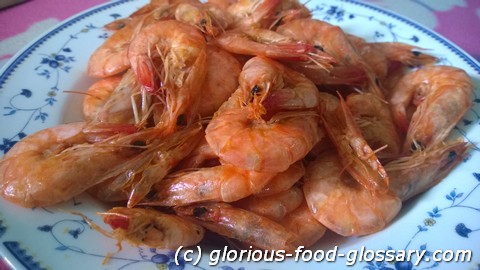Deutsch: Gedämpfte Garnelen / Español: Camarones al vapor / Português: Camarões no vapor / Français: Crevettes à la vapeur / Italiano: Gamberi al vapore
Halabos na Hipon in the food context refers to a traditional Filipino method of cooking shrimp, where the shrimp are quickly steamed or boiled in their own juices, often with only minimal seasonings such as salt and sometimes a little water. The simplicity of this cooking method highlights the natural flavor of the shrimp, making it a beloved dish for its straightforwardness and the freshness it brings to the table. The term "halabos" generally refers to the method of cooking seafood, particularly Shellfish, in a minimal amount of liquid, and "hipon" means shrimp in Tagalog.
Description
The essence of Halabos na Hipon lies in its minimalistic approach, allowing the sweetness and tender texture of fresh shrimp to shine through. Often, the shrimp are cooked with their shells on, which helps retain their flavor and moisture. Once cooked, the shrimp turn a vibrant pink, indicating they are ready to be enjoyed. This dish can be served as an Appetizer or main course, typically accompanied by steamed rice and a dipping sauce, such as vinegar with garlic and chili, to enhance its flavors.
Application Areas
Halabos na Hipon is commonly served as:
- Appetizer or Starter: Offering a light and flavorful beginning to a meal.
- Main Dish: Paired with steamed rice for a simple yet satisfying meal.
- Seafood Feast: Part of a larger seafood spread, showcasing the freshness and diversity of local marine offerings.
Well-Known Examples
While Halabos na Hipon itself is quite straightforward, variations might include:
- Halabos na Hipon with Soda: Some versions involve cooking the shrimp in a carbonated beverage, such as 7-up or Sprite, to add a subtle sweetness.
- Spicy Halabos na Hipon: Adding sliced chili peppers to the dish for those who prefer a spicy kick.
Recipes
A basic recipe for Halabos na Hipon involves:
-
- Fresh shrimp, with or without heads, but usually with shells on
- Salt, to taste
- Optional: a small amount of water or soda for the cooking process
-
Preparation:
- Clean the shrimp by rinsing under cold water. Optionally, you can remove the antennae for ease of cooking and eating.
- In a pan, combine the shrimp with a sprinkle of salt (and a bit of water or soda if using). Cover and cook over medium heat.
- Let the shrimp steam in their own juices, stirring occasionally, until they turn pink and are cooked through, about 5 to 10 minutes depending on their size.
- Serve immediately, with a side of steamed rice and a dipping sauce if desired.
Treatment and Risks
Halabos na Hipon is a healthy cooking method that preserves the nutritional value of the shrimp. However, it's essential to source fresh shrimp to avoid the risk of foodborne illnesses. Cooking the shrimp properly, until they turn pink and opaque, ensures they are safe to eat. For individuals with shellfish allergies, consuming shrimp can pose health risks and should be avoided.
Similar Terms or Synonyms
- Steamed Shrimp
- Boiled Shrimp
Summary
Halabos na Hipon is a testament to the beauty of simplicity in Filipino cuisine, showcasing how minimal seasoning and preparation can highlight the natural flavors of fresh seafood. This dish, beloved for its ease of cooking and delicious outcome, remains a staple in Filipino dining, celebrated for both its flavor and the culinary tradition it represents.
--

Related Articles to the term 'Halabos na Hipon' | |
| 'Halabos' | ■■■■■■■■■ |
| Halabos is a Filipino term which means to steam shellfish with little water. . . . . . . Read More | |
| 'Crispy Hipon' | ■■■■■■■■■ |
| In the food context, \'Crispy Hipon\' refers to a popular Filipino dish that consists of deep-fried shrimp, . . . Read More | |
| 'Ginisang Ampalaya' | ■■■■■■■■ |
| Ginisang Ampalaya in the food context refers to a traditional Filipino dish made from sautéed bitter . . . Read More | |
| 'Lechong Liempo' | ■■■■■■■■ |
| Lechong Liempo in the food context refers to a Filipino dish that consists of roasted or grilled pork . . . Read More | |
| 'Nilagang Buto ng Baka' | ■■■■■■■■ |
| Nilagang Buto ng Baka in the food context refers to a traditional Filipino soup made by slowly boiling . . . Read More | |
| 'Paksiw na Bangus' | ■■■■■■■■ |
| Paksiw na Bangus in the food context refers to a traditional Filipino dish made with bangus (milkfish), . . . Read More | |
| 'Gruel' | ■■■■■■■■ |
| Gruel is a type of thin, often runny cereal-based dish, commonly made from grains like oats, wheat, rye, . . . Read More | |
| 'Marinduque' | ■■■■■■■■ |
| Marinduque is a province in the Philippines known for its unique and traditional cuisine. The food culture . . . Read More | |
| 'Pinais na Isda' | ■■■■■■■■ |
| Pinais na Isda is a traditional Filipino dish that involves wrapping fish or shrimp in banana leaves . . . Read More | |
| 'Sinaing na Tulingan' | ■■■■■■■■ |
| Sinaing na Tulingan is a traditional Filipino dish originating from the Batangas region, known for its . . . Read More | |
